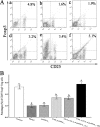Induction of immune tolerance in asthmatic mice by vaccination with DNA encoding an allergen-cytotoxic T lymphocyte-associated antigen 4 combination
- PMID: 21346053
- PMCID: PMC3122522
- DOI: 10.1128/CVI.00434-10
Induction of immune tolerance in asthmatic mice by vaccination with DNA encoding an allergen-cytotoxic T lymphocyte-associated antigen 4 combination
Abstract
Allergen-specific immunotherapy is a potential treatment for allergic diseases. We constructed an allergen-cytotoxic T lymphocyte-associated antigen 4 (CTLA-4)-encoding DNA vaccine, administered it directly to antigen-presenting cells (APCs), and investigated its ability and mechanisms to ameliorate allergic airway inflammation in an asthmatic mouse model. An allergen-CTLA-4 DNA plasmid (OVA-CTLA-4-pcDNA₃.₁) encoding an ovalbumin (OVA) and the mouse CTLA-4 extracellular domain was constructed and transfected into COS-7 cells to obtain the fusion protein OVA-CTLA-4, which was able to bind the B7 ligand on dendritic cells (DCs), and induced CD25⁺ Foxp3⁺ regulatory T (Treg) cells by the coculture of naive CD4⁺ T cells with DCs in vitro. In an animal study, BALB/c mice were sensitized and challenged with OVA to establish the asthmatic model. Vaccination with a high dose of OVA-CTLA-4-pcDNA₃.₁ significantly decreased interleukin-4 (IL-4) and IL-5 levels and eosinophil counts and prevented OVA-induced reduction of the gamma interferon level in the bronchoalveolar lavage fluid. In addition, these mice suffered less severe airway inflammation and had lower levels of OVA-specific IgE and IgG1 titers in serum. Also, high-dose OVA-CTLA-4-pcDNA₃.₁ vaccination inhibited the development of airway hyperreactivity and prevented OVA-induced reduction of the percentages of Foxp3⁺ Treg cells in the spleen. Our results indicate that a high dose of allergen-CTLA-4-encoding DNA vaccine was more effective in preventing an allergen-induced Th2-skewed immune response through the induction of Treg cells and may be a new alternative therapy for asthma.
Figures









Similar articles
-
Potential therapy of Fc-antigen combination-encoding DNA vaccination in mouse allergic airway inflammation.Clin Exp Immunol. 2008 Oct;154(1):115-22. doi: 10.1111/j.1365-2249.2008.03736.x. Epub 2008 Aug 22. Clin Exp Immunol. 2008. PMID: 18727625 Free PMC article.
-
4-1 BB stimulation inhibits allergen-specific immunoglobulin E production and airway hyper-reactivity but partially suppresses bronchial eosinophilic inflammation in a mouse asthma model.Clin Exp Allergy. 2006 Mar;36(3):377-85. doi: 10.1111/j.1365-2222.2006.02445.x. Clin Exp Allergy. 2006. PMID: 16499650
-
Administration of polysaccharides from Antrodia camphorata modulates dendritic cell function and alleviates allergen-induced T helper type 2 responses in a mouse model of asthma.Immunology. 2010 Mar;129(3):351-62. doi: 10.1111/j.1365-2567.2009.03175.x. Epub 2009 Nov 11. Immunology. 2010. PMID: 19909376 Free PMC article.
-
Potential of immunoglobulin A to prevent allergic asthma.Clin Dev Immunol. 2013;2013:542091. doi: 10.1155/2013/542091. Epub 2013 Apr 11. Clin Dev Immunol. 2013. PMID: 23690823 Free PMC article. Review.
-
Control and regulation of peripheral tolerance in allergic inflammatory disease: therapeutic consequences.Chem Immunol Allergy. 2008;94:178-188. doi: 10.1159/000155086. Chem Immunol Allergy. 2008. PMID: 18802347 Free PMC article. Review.
Cited by
-
Combination immunotherapy with 4-1BBL and CTLA-4 blockade for the treatment of prostate cancer.Clin Dev Immunol. 2012;2012:439235. doi: 10.1155/2012/439235. Epub 2012 Jan 23. Clin Dev Immunol. 2012. PMID: 22312406 Free PMC article.
-
A DNA vaccine encoding a chimeric allergen derived from major group 1 allergens of dust mite can be used for specific immunotherapy.Int J Clin Exp Pathol. 2014 Aug 15;7(9):5473-83. eCollection 2014. Int J Clin Exp Pathol. 2014. PMID: 25337189 Free PMC article.
-
Immune checkpoint molecules in prevention and development of asthma.Front Immunol. 2023 Feb 14;14:1070779. doi: 10.3389/fimmu.2023.1070779. eCollection 2023. Front Immunol. 2023. PMID: 36865540 Free PMC article. Review.
-
DGKα DNA vaccine relieves airway allergic inflammation in asthma model possibly via induction of T cell anergy.Int J Clin Exp Pathol. 2013 Oct 15;6(11):2404-11. eCollection 2013. Int J Clin Exp Pathol. 2013. PMID: 24228102 Free PMC article.
-
Anti-HMGB1 neutralizing antibody ameliorates neutrophilic airway inflammation by suppressing dendritic cell-mediated Th17 polarization.Mediators Inflamm. 2014;2014:257930. doi: 10.1155/2014/257930. Epub 2014 May 15. Mediators Inflamm. 2014. PMID: 24959003 Free PMC article.
References
-
- Abe M., et al. 2008. Foxp3 expression on normal and leukemic CD4+ CD25+ T cells implicated in human T-cell leukemia virus type-1 is inconsistent with Treg cells. Eur. J. Haematol. 81:209–217 - PubMed
-
- Ahrens B., et al. 2009. BCG priming of dendritic cells enhances T regulatory and Th1 function and suppresses allergen-induced Th2 function in vitro and in vivo. Int. Arch. Allergy Immunol. 150:210–220 - PubMed
-
- Akdis M., Akdis C. A. 2007. Mechanisms of allergen-specific immunotherapy. J. Allergy Clin. Immunol. 119:780–791 - PubMed
-
- Cosmi L., et al. 2004. Th2 cells are less susceptible than Th1 cells to the suppressive activity of CD25+ regulatory thymocytes because of their responsiveness to different cytokines. Blood 103:3117–3121 - PubMed
-
- Cusi M. G., et al. 2004. Efficient delivery of DNA to dendritic cells mediated by influenza virosomes. Vaccine 22:735–739 - PubMed
Publication types
MeSH terms
Substances
LinkOut - more resources
Full Text Sources
Medical
Research Materials
Miscellaneous

